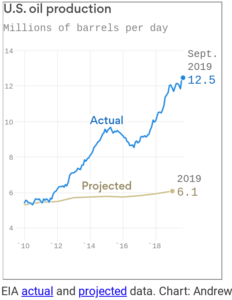VP, @Mike_Pence 👏👏
"[T]he United States has reduced CO2 more than the countries that are still in the Paris Climate Accord, but we’ve done it through innovation. And we’ve done it through natural gas and fracking, which Senator, the American people can go look at the record."
— Clear Energy Alliance (@clearenergy) October 8, 2020
#
2018 Study: U.S. Leads World In Reducing CO2 Emissions, While UN Paris Accord Nations Break Promises – Moore notes that America was able to make this progress despite never signing the Kyoto Protocol, never enacting a carbon tax, refusing to impose a “cap and trade” carbon emission program, and “that environmental villain Donald Trump pull[ing] America out of the Paris climate accord.”
So America is doing pretty well on its own. But how’s Europe doing? Not great overall. BP’s study found that European Union emissions were up overall (1.5%), “with just Spain accounting for 44% of the increase in EU emissions.” The UK and Denmark, however, did report their lowest carbon emissions yet, though still not matching the U.S.
Shock Epic Fails: The decade that blew up energy predictions – USA energy boom, CO2 emissions drop defied predictions! See the charts! – These five charts show U.S. Energy Information Administration projections from a decade ago, with current EIA data to show what actually happened.
Steve Milloy: President Trump’s Energy Victory Lap on his ‘energy dominance’ policy
GREEN REVOLUTION? SOLAR & WIND PRODUCED JUST 3% OF GLOBAL ENERGY – Wind and solar energy generation is growing, but it’s still an incredibly small part of the global energy mix, according to statistics compiled by the oil giant BP. Meanwhile, fossil fuels — coal, natural gas and oil — accounted for 85% of global energy consumption in 2018, BP reported Tuesday as part of its annual energy report. In fact, BP reported the U.S. led the world in oil and natural gas production growth. U.S. petroleum output saw the biggest annual growth ever recorded in any country, BP said. In other words, shale is booming. The U.S. surpassed Saudi Arabia and Russia in 2018 to become the world’s largest oil-producing nation. “Oil remains the most used fuel in the energy mix,” BP reported in its annual energy review. “Coal is the second largest fuel but lost share in 2018 to account for 27%, its lowest level in 15 years. The share of natural gas increased to 24%, such that the gap between coal and gas has narrowed to three percentage points.”
EIA data 2018: Wind & solar met 3% of U.S. energy after $50 billion in subsidies – Fossil Fuels 81%– The EIA (U.S. Energy Info Admin) AEO 2019 report shows that in year 2018 wind and solar energy resources provide about 3% of U.S. total energy consumption while fossil fuel energy resources provide about 81% of total energy use.PTC (Production Tax Credit) subsidies for renewable solar and wind projects in the U.S. have now reached about $50 billion dollars in cumulative payments through year 2018 with these resources providing about 3% of our countries total energy consumption in that year…Additionally these annual wind and solar subsidiies now total more than $8 billion dollars per year.







